Related Products
For Professionals
- Amplification
- Assessment of Student Skills, Challenges, Needs
- Early Childhood: Infants, Toddlers, Preschool
- Hearing Loss – Identification, Impact and Next Steps
- IDEA Law Summary Information
- Language and Speech Development Issues
- Legal Issues in Serving Children with Hearing Loss
- Listening (Auditory Skills) Development
- Planning to Meet Student Needs
- Self-Advocacy Skills for Students with Hearing Loss
- Self-Concept: How the Child with Hearing Loss Sees Himself
- Social Skills
- Speech Perception & Learning
Related Teacher Tools Takeout Items
Impact of Hearing Loss on Listening, Learning and Social Interactions handouts
Age 4-6 – Metacognitive Awareness – Building Self-Confidence & Resilience
Self-Concept and Your Child
Addressing the Shortage of Deaf and Hard of Hearing Teachers

In the realm of special education there is a significant shortage of teachers who are proficient in serving the needs of students who are deaf or hard of hearing (DHH). This scarcity not only compromises the quality of education for DHH students but also highlights systemic challenges within the educational landscape.
Causes of the Shortage:
1. Lack of Specialized Training Programs: One of the primary factors contributing to the shortage of DHH teachers is the absence of specialized training programs. Teaching DHH students requires unique skills and knowledge in areas such as sign language, auditory rehabilitation, and assistive technology. However, many teacher preparation programs have closed their doors to Deaf and Hard of Hearing Education majors at both undergraduate and graduate levels.
2. Low Retention Rates: Retention rates among DHH teachers are disproportionately low compared to those of teachers in other specialties. The challenging nature of the work, coupled with inadequate support and resources, often leads to burnout and disillusionment among DHH educators. Without effective strategies to support and retain DHH teachers, the shortage will continue to persist.
3. Limited Career Opportunities: Another contributing factor to the shortage is the limited career advancement opportunities available to DHH teachers. Many educational institutions do not provide pathways for DHH teachers to advance into leadership roles or pursue specialized areas of expertise.
4. Retirement Rates: Employment demographics indicate that baby-boomers made up approximately 40% of the labor market in 2008 with retirements between 2010 and 2020 expected to be the largest since WWII (Aaronson & Meckel, 2008). With the lack of teacher preparation programs, we have a high demand and low supply creating major concerns in the field of deaf education.
Concerns:
- The newly developed “quick fix” programs do not adequately address the specialized training needs for Teachers of the Deaf and Hard of Hearing (TODHH), leaving aspiring educators ill-equipped to teach DHH students effectively.
- States are forced to hire teachers who do not have a background in deaf education, and have no choice but to provide emergency certification, in order to meet the minimum requirements of IDEA. Because TODHHs require a unique set of skills in order to teach students with hearing loss, the quality of deaf education is lacking.
- Programming for students with hearing loss may have an inadequate framework and service times may not meet the needs of the child with hearing loss.
Strategies for Addressing the Shortage:

1. Expand Specialized Training Programs: To address the shortage of DHH teachers, there is a need to expand and enhance specialized training programs. This includes incorporating coursework on sign language, deaf culture, and instructional strategies tailored to the needs of DHH students into teacher preparation programs.
2. Additionally, creating incentives such as scholarships or loan forgiveness programs for aspiring DHH teachers can help attract more individuals to the field.
3. Improve Support and Resources: Providing adequate support and resources is essential for retaining DHH teachers. This includes access to professional development opportunities, mentorship programs, and assistive technologies that enhance teaching effectiveness. By investing in the professional growth and well-being of DHH educators, educational institutions can improve retention rates and create a more sustainable workforce.
4. Foster Career Advancement Opportunities: Educational institutions should prioritize creating pathways for career advancement for DHH teachers. This can include opportunities for leadership roles, specialized certifications, and funding for advanced education and training. “Critical Need” pay for teachers who are in the field of deaf education, as well as recognizing and rewarding the expertise of DHH educators, institutions can incentivize talented individuals to remain in the field and contribute to its growth and development.
5. What to Do in the Meantime? Travel time for itinerant teaching positions can be quite daunting, often decreasing the level of service times that can be offered to students for hearing support services. Offering virtual services, while not always the preferred method of direct services, can be a temporary solution, as the TODHH can offer direct service times that are appropriate to meet the needs of the student and carry more students on their caseloads.
“Grow your own” type of educational programs using the journeyman approach, can be an effective alternative, while providing on the job training to supplement coursework at the university level.
The shortage of DHH teachers represents a significant challenge within the education system that requires urgent attention and concerted action. Prioritizing the root causes of the shortage and implementing critical strategies to attract, support, and retain DHH educators, we can create a more inclusive and equitable learning environment for all students. It is imperative that policymakers, educational institutions, and stakeholders collaborate to ensure that every DHH student has access to qualified and dedicated teachers who can support their academic and personal growth.
Click Here to download this article



